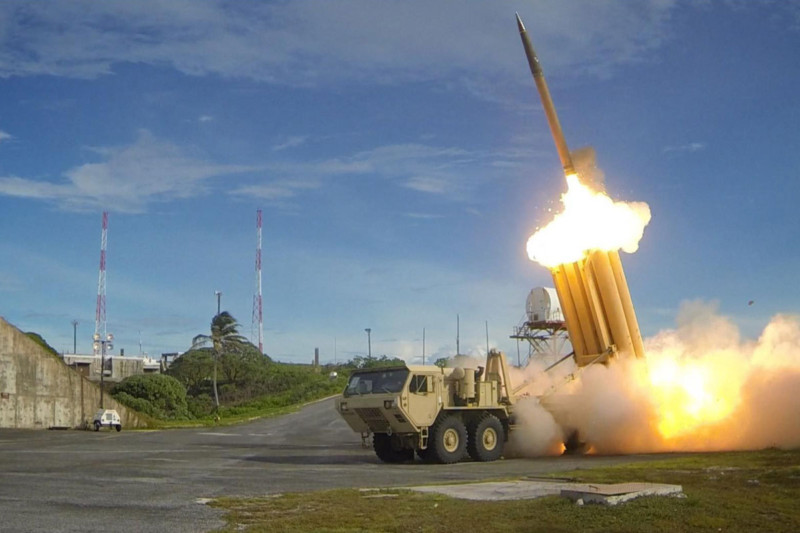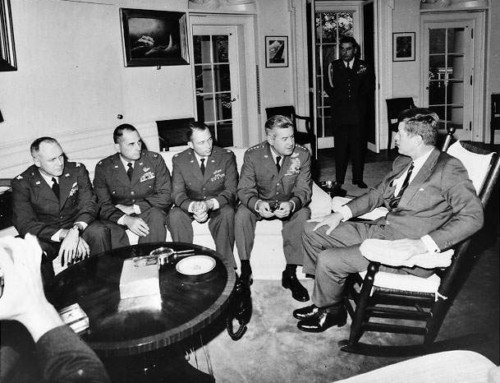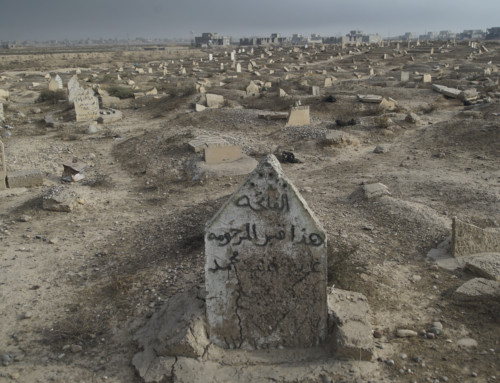Above Photo: America’s THAAD (Terminal High Altitude Area Defense) missile defense system designed to shoot down short and medium range missiles, recently installed in South Korea over the objections of China.
Dr. Peter Pry is the Executive Director of the Task Force on National Homeland Security, is the Chief of Staff of the Congressional EMP (Electric Magnetic Pulse) Commission and is considered one of the country’s most knowledgeable experts on nuclear weapons technology. He is the undisputed preeminent authority on the existential threat presented by the proliferation of EMP weapons and gained national prominence in various testimonies before Congress where he has categorically stated that the detonation of a single EMP weapon by a rogue state such as North Korea or Iran could destroy the US.
In September of 2014, Peter and I collaborated on a Blaze Magazine article, Blackout, where he outlined how a single EMP nuclear weapon, detonated at apogee (between 50 to 200 miles above the US), would destroy the country’s entire electrical grid. Airplanes would fall out of the sky, our cars would not start, banking, nearly all non-barter related commerce would cease, and nine out of ten Americans would eventually die due to total societal collapse.
I recently caught up with Peter to ask him what he thought about the new North Korean nuclear missile crisis.
Kelley: If Trump’s negotiations with President Xi Jinping and the Chinese government fail to bring about regime change in North Korea; can the US successfully take out their nuclear sites and do we know where they all are?
Pry: We don’t know where they all are. We do, however, have the ability, I believe, to do a successful preemptive strike. Which doesn’t mean we get a hundred percent of everything. But we would be able to effectively disarm them, certainly of their ICBM’s (intercontinental ballistic missiles). They don’t have that many of them, maybe only a dozen. So, we have this window of opportunity when it comes to their ICBM’s.
Kelley: How should the strike be conducted?
Pry: It should include everything in our arsenal, our own EMP, cyber, conventional forces (ours and Korea’s). We can get most of their stuff in a first strike but there’s no guarantee we get all of it, even all of those small number of ICBM’s. But if any of those survive, our missile defense forces should be able to handle them.
Kelley: But what about all those vast numbers of short-range missiles we read are pointed at South Korea. Can all of those be taken out in a surprise attack?
Pry: It’s problematic when you’re talking about medium-range missiles, the no-dong’s. Most are not nuclear-armed. But I think we are grossly underestimating the number of nuclear warheads they have. They could have 100 nuclear weapons, most of them mounted on the no-dong’s. So there is no doubt, our allies would be more at risk from some of these surviving missiles. They hide them in tunnels and under bridges. But what are we going to do? Wait until they have enough (nuclear weaponized missiles) to make preemption impossible?
Kelley: Is North Korea reaching critical mass in terms of its nuclear weapons capability?
Pry: Not yet. Through our offensive and defensive systems we still have a reasonable chance to get all of their weapons and systems. But some of the no-dongs could get through and hit some cities.
Kelley: Cities where?
Pry: South Korea or US military bases in Japan. They could even get off an EMP attack which would be utterly bad news. We now have a rapidly vanishing window of opportunity. If they were to hit our allies with an EMP, we could help them recover. But if they deploy many more nuclear-armed short and long-range missiles, the problem becomes unmanageable. The key is to stop them before they get more ICBM’s, when they can hold the US mainland at risk. No American president is going to take out North Korea, at the risk of Los Angeles or Chicago, for the security purposes of Japan and South Korea.
Kelley: But haven’t we’ve lived for some time with other bad actors getting nuclear weapons such as Russia?
Pry: It’s not as if (Kim Jung UN of)North Korea is an acceptable rational actor. Sooner or later he will use those missiles. It’s better to get it over now while we can win. In fact, it’s still possible we could do a preemptive strike so that he won’t be able to get a glove on us. But I can’t guarantee we can now get all the medium range missiles because there are so many of them.
Kelley: In my view, most Americans don’t believe North Korea has anything like 100 nuclear-armed short range missiles.
Pry: The no-dongs were the first thing they armed. They can carry a (nuclear) one-ton payload. The no-dongs are nuclear armed! The CIA has attested to this since ’08. But the mainstream view is that they have only about 20 nuclear weapons. But I think this is a total fantasy. That assumes we have perfect knowledge of their program when we know they have a vast nuclear development complexes underground.
Kelley: I’ve heard some national defense experts estimate that, if the US were to attempt a preemptive strike on the North, as many as 250 thousand South Koreans would die. It sounds to me that you don’t agree.
Pry: I won’t issue an estimate. I agree this thing could escalate into another Korean War. But that’s the risk we have to run because if we allow the North to fully nuclearize, we could be facing hundreds of millions of Americans dead in an EMP attack, in other words, an existential threat to the US. So, the possibility of hundreds of thousands of dead on the Korean Peninsula is a risk we have to take.
Kelley: In our first article which focused on North Korea’s development of an EMP weapon you describe how they had put up a satellite that passes over DC and our Eastern Seaboard during each orbit and which could be easily armed with an EMP nuclear weapon. If we execute a preemptive strike, do we have any counter measures for that?
Pry: There are things we can do about it. We need to harden our grid.
Kelley: But given how rapidly this crisis is unfolding, isn’t it true that we don’t have two years, which is the minimum time it would take to harden the grid?
Pry: I agree it’s not the answer to a crisis with North Korea. James Woolsey (former CIA Director) and I have advocated in writing that we shoot down those satellites. They now have two up there. The first one has been in orbit since 2012. It gets harder for us to take them out the more satellites they launch because what they’re doing is creating a constellation so that they always have one satellite over us. We can’t let that happen because it would mean that the window of opportunity will be closed…if there are nukes on those satellites. We don’t know if they are nuclear- armed or not.
Kelley: So, let’s assume that both North Korea’s satellites orbiting above us are nuclear armed. What does Trump do?
Pry: There’s a real possibility that there are super EMP weapons on those satellites. And there is a way to weaponize them so that you get detonation on demand or when it is intercepted. This means that you get a detonation wherever the interception happens. You can’t shoot it down when it’s over the US or one of our allies. You’ve got to take it out over broad ocean or over one of the polls so that it’ll do the least damage to humanity.
Kelley: So, can the US take them out as part of a preemptive strike on North Korea?
Pry: It was easier to do so when there was just one up there. Now that they’ve got two up there, you’ve got to take them out at the same time and when they are both over non-threatening locations. We could still do that but what if they put a third up there? This is what I’ve been telling the Trump officials. We’d then have to take out all three when each were not over the US or our allies.
Kelley: Let’s turn to their ICBM’s. How much time do we have before North Korea can reach the West Coast of the US with a nuclear-armed ICBM?
Pry: The mainstream view of this which is repeated over and over even by Trump Administration officials is that it could be as early as next year or within a few years. I disagree. I think they can already do that. I think some of their KN08 and KN14 (long-range) missiles are already nuclear-armed. Just because they haven’t been flight tested means nothing. They’re based on Russian road mobilized designs and launchers of Chinese designs. Both are proven.
Kelley: Why do you think the media and even the Trump Administration are so unwilling to tell us the truth about the threat posed by North Korea?
Pry: There is a double standard when it comes to North Korea. Nobody says that India or Pakistan or Israel doesn’t have nuclear-armed missiles simply because they haven’t demonstrated them. On April 16, 2013 Obama told the New York Times the Kin Jong Un could not deliver on his threats to strike the US with nuclear weapons because he didn’t want to accept responsibility for North Korea becoming a nuclear missile state on his watch and so that he wouldn’t have to face such an emergency and take drastic steps against the regime. His own Department of Defense assessed that North Korea had long-range nuclear missiles. That somehow didn’t get through to the press. It stinks to high heaven.
Kelley: If we launch a preemptive strike on North Korea, what will China do?
Pry: I think if we do it right and posture our strategic forces so that all ballistic missile submarines are at sea, our strategic bombers off their bases and in holding patterns up in the arctic, China will not put itself at risk to save North Korea.
Kelley: Neither would Russia?
Pry: Neither would Russia. But with respect to China, that scenario is only true for the present. China is building up its nuclear arsenal. They’ve tested a MIRV (multiple intercontinental reentry vehicle) that can deliver ten warheads. If they were to deploy 50 of them, they would have a superior first-strike capability against the US. But they don’t have that right now. We’ve got escalation dominance. If we lose that, all bets are off.
Kelley: Why are China and Russia supporting this horrific regime in North Korea?
Pry: I believe the reason that both China and Russia are in this game with North Korea is that they hope to win without war. They are helping it go nuclear because they want North Korea to pose a threat to the US and to our allies in the region. They want the risk associated with our upholding the security guarantees of our allies to be so great that will give up and withdraw. They know that Americans will not regard as a reasonable trade, placing Los Angeles or Chicago at risk to safeguard South Korea or Japan. China and Russia would like to move us from Obama’s leading from behind to outright isolationism. And if that happens, China and Russia will have won this new Cold War. Sun Tzu said that the greatest victory is to achieve victory without fighting. This is what North Korea’s nuclear weapons program means to them. But if we take out the North Koreans’ nuclear arsenal, I don’t think it’s in China or Russia’s plans to go to war for North Korea.
In December of 1941, after Pearl Harbor, FDR made the monumental decision to ask Congress for a declaration of war on both Japan and Germany even though Japan not Germany mounted the attack. Today both China and Russia have interests in keeping the North Koreans in possession of their short and long-range nuclear weapon threat. And given that, it seems that President Trump has an even bigger decision to make because if does or doesn’t act militarily, a miscalculation could lead to a nuclear world war.
Corroborating Statements
After my interview with Pry, I did some further research to see what others were saying about the threat posed by North Korea, particularly its potentially nuclear-armed satellites. I found a James Woolsey interview conducted by David Greene of National Public Radio. When the former CIA Director stated his primary concern for the country was an EMP attack from North Korean satellites that are now in orbit over the US, it was obvious that Greene could not process the information.
Greene: That’s not a threat that you hear so much about as, like, a missile striking a Korean or American city. So that’s something I didn’t know about.
Woolsey: It’s much harder to hit a city than it is to detonate something in space that’s just put in a satellite. So, we’re not talking about some gigantic project, just detonating a nuclear weapon in a satellite in orbit, in low Earth orbit.
Greene: And you’re saying the North Koreans are closer to doing that than to have an actual nuclear weapon on top of a missile?
Wolsey: They’re closer to doing that than they are to being able to hit a target in the United States.
Michael Maloof, former senior security policy analyst in the office of the Secretary of Defense told World Net Daily in April of this year that North Korea already has the capability to launch a nuclear attack on the United States.
In February of last year Henry Cooper, President Ronald Reagan’s chief representative in the “Star Wars” initiative negotiations with the Soviet Union and SDI director under President George H.W. Bush – said North Korea was preparing its Sohae satellite complex for a launch on a southern trajectory. Cooper went on to say the United States lacks sufficient anti-ballistic missile defenses in the southern part of the U.S., especially if the satellite turns out to be a nuclear device that could orbit above the U.S. and explode at a high altitude, affecting the lives of all Americans.
Finally, he said it would be difficult to distinguish a test from an actual attack, and the best way to counter such a threat to the U.S. homeland is to knock out the missile at the time it begins its trajectory over a southern polar route.






